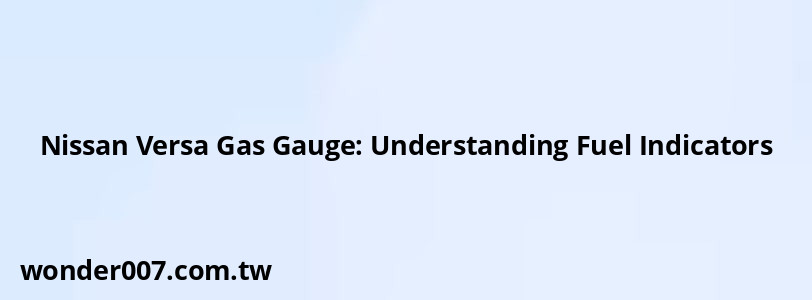Nissan Versa Gas Gauge: Understanding Fuel Indicators

The Nissan Versa's fuel gauge is designed to provide accurate information about your vehicle's fuel level. Understanding how to read and interpret this gauge is crucial for managing your fuel consumption effectively.
Fuel Gauge Components
The Nissan Versa's fuel gauge consists of several key components:
- Fuel level indicator: A gray bar that shows the current fuel level
- Red zone: Indicates when fuel is critically low
- Fuel pump icon: Shows which side the fuel filler door is located
- Low fuel warning light: Illuminates when fuel is low
Reading the Fuel Gauge
To accurately read your Nissan Versa's fuel gauge:
1. Observe the gray bar, which is the primary fuel level indicator
2. Pay attention to the red zone at the bottom of the gauge
3. Note that the red light is always on, serving as a visual marker for the "get fuel immediately" zone
4. When the gray bar reaches the red zone, prepare to refuel soon
Digital Display Features
Many Nissan Versa models include additional digital display features:
- Miles to empty: Shows estimated distance remaining on current fuel
- MPG indicator: Displays real-time fuel efficiency
When fuel is very low, the "miles to empty" display may go blank. This typically occurs when there are about 30-40 miles of range left.
Refueling Tips
When refueling your Nissan Versa:
1. Use the fuel pump icon to identify the correct side for the fuel filler door
2. Pull the fuel door release located below the instrument panel
3. Turn the fuel cap counterclockwise to remove it
4. After refueling, turn the cap clockwise until you hear a click
5. Ensure the fuel cap is properly tightened to avoid warning messages
Fuel Gauge Accuracy
The Nissan Versa's fuel gauge is generally accurate, but keep in mind:
- Fuel level can fluctuate on hills or during turns due to fuel movement in the tank
- The gauge may show full for a while after refueling before dropping
- Some users report being able to drive for several miles after the gauge shows empty
Troubleshooting
If you experience issues with your fuel gauge:
- Inconsistent readings may indicate a faulty fuel sending unit
- Persistent low readings when the tank is full could be due to a malfunctioning float in the fuel pump
- If problems persist, consult a Nissan dealer or qualified mechanic
Understanding your Nissan Versa's fuel gauge helps ensure you never run out of gas unexpectedly and can manage your fuel consumption efficiently.
Related Posts
-
Miles on a Quarter Tank: Fuel Efficiency Guide
29-01-2025 • 185 views -
Chevy Silverado Fuel Pump Reset Switch: A Complete Guide
28-01-2025 • 177 views -
Nissan Security Indicator Light: Troubleshooting Guide
28-01-2025 • 208 views -
Freightliner Warning Lights: Understanding Dashboard Alerts
26-01-2025 • 193 views -
Active Eco: Understanding Hyundai Sonata's Fuel Efficiency Feature
27-01-2025 • 205 views
Latest Posts
-
Power Steering Fluid Leak On Passenger Side
01-02-2025 • 460 views -
Are O2 Sensors Covered Under Warranty
01-02-2025 • 378 views -
Rear Brake Caliper Piston Won't Compress
01-02-2025 • 361 views -
How To Turn Off Paddle Shifters Mercedes
01-02-2025 • 387 views -
2015 Chevy Traverse AC Recharge Port Location
01-02-2025 • 417 views
Popular Posts
-
Hino Warning Lights: Understanding Dashboard Alerts
26-01-2025 • 794 views -
V12 Engine Costs: What You Need to Know
26-01-2025 • 688 views -
Power Steering and ABS Light On: Causes and Solutions
27-01-2025 • 649 views -
Toyota Hiace: Fuel Efficiency Insights for 2025
26-01-2025 • 645 views -
EPC Light: Understanding Causes and Solutions
26-01-2025 • 1065 views
